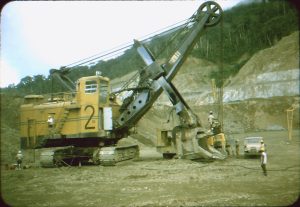Thirty-five years after Rio Tinto abandoned the Panguna Copper Mine, leaving behind a trail of destruction, poison and suffering, the forgotten residents of Bougainville are still waiting for answers.
As a child, I witnessed the transformation of our lush and serene Panguna home into a dystopian landscape, owing to the reckless exploitation carried out by Rio Tinto and its subsidiary Bougainville Copper (BCL). As a young boy, I would go with friends to swim in the crystal-clear Kawerong River during the holidays. We could even manage to catch the fish in the river by simply throwing our spears while standing on top of the rocks.
Slowly but surely, the Kawerong River began to fill up with the waste and tailings from the mine. Our villages and traditional sacred and spiritual sites along the river started to disappear, buried under meters of tailings.
This is not just my story, but the story of thousands of Bougainville residents who have endured over five decades of environmental devastation and social upheaval caused by the careless mismanagement of the mine. Today, we are united in a class action lawsuit against Rio Tinto and BCL, demanding compensation.
During the course of the mine’s operation, between 1972 and 1989, about 600 million tons of waste tailings were dumped directly into the Jaba-Kawerong river system. In 1989, a nine-year civil war erupted, resulting from disputes over the mine’s operations and profits, fracturing our society and claiming countless lives, and bringing operations at the mine to a halt. In 2016, Rio Tinto simply walked away from the abandoned mine and the devastation it had caused, giving its 53.8 percent stake to the Papua New Guinea government.
Neither Rio Tinto nor BCL have made any commitment to rehabilitate the environmental and social impacts of their activities. The result? A community left to grapple with polluted rivers, poisoned ecosystems, and destroyed livelihoods.
Our ancestral lands have been devastated. Toxic metals from tailings and waste rock pollute previously pristine forests and rivers, endangering biodiversity and causing long-lasting environmental damage. The rivers we once fished in have become symbols of our lost heritage and broken connection to the land.
Deforestation, erosion, contamination, and changes to the landform mean that jungles, fruit trees, cocoa trees, and food gardens have disappeared or been degraded, harming our ability to sustain ourselves from the land. The mine’s careless operations did not just alter our environment; they shattered our livelihoods and cultural fabric.
The health of our people is threatened by the pollution and contamination caused by the mine. Respiratory illnesses, skin diseases, and infections have prevailed, worsened by our inadequate healthcare system.
It is disheartening that our own government appears more focused on reopening the mine than supporting its people in seeking justice. We should not have to choose between economic development and the preservation of our environment and cultural heritage. Sustainable development, and even the potential for the mine to reopen in the future, may be possible, but would require resolution of our claims and a commitment to responsible practices and to uphold the well-being of local communities.
Our community has been haunted by this trauma for far too long. The class action lawsuit we have filed is not just about compensation; it is about accountability. It is about making Rio Tinto and BCL recognize and address the harm they have caused. These corporations exploited our resources and reaped enormous profits, before abandoning the mine, leaving us to deal with the consequences. Our demands are simple: rehabilitation of the environment and compensation for the profound suffering we have endured.
Our lawsuit has the support of 71 local clan leaders, who have written to the CEO of Rio Tinto detailing the human impact of the company’s actions. The letter is a poignant reminder of the real, lived experiences of our people.
It is now time for Rio Tinto and BCL to take responsibility and act.
In our community, the land is more than just a physical space; it is our life, our survival, and the air we breathe. The destruction and suffering caused by the mismanagement of the Panguna Copper Mine cannot be undone, but justice can be served.

































